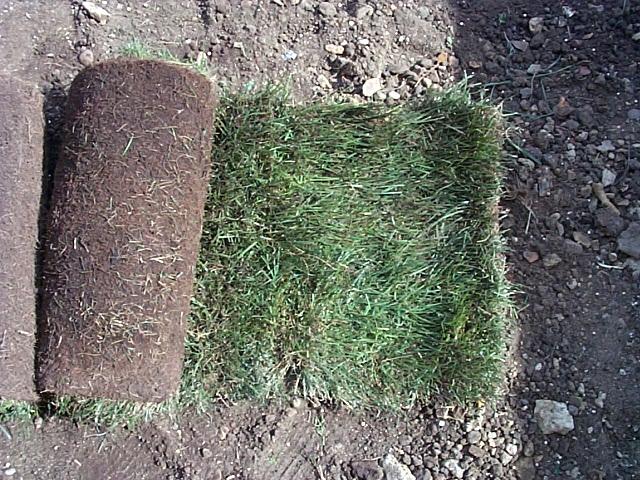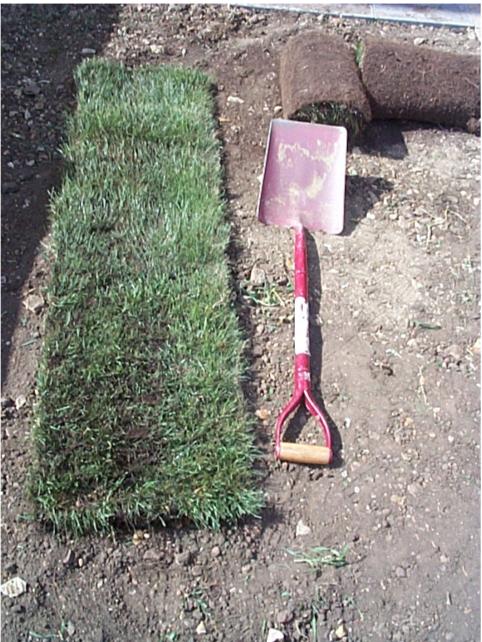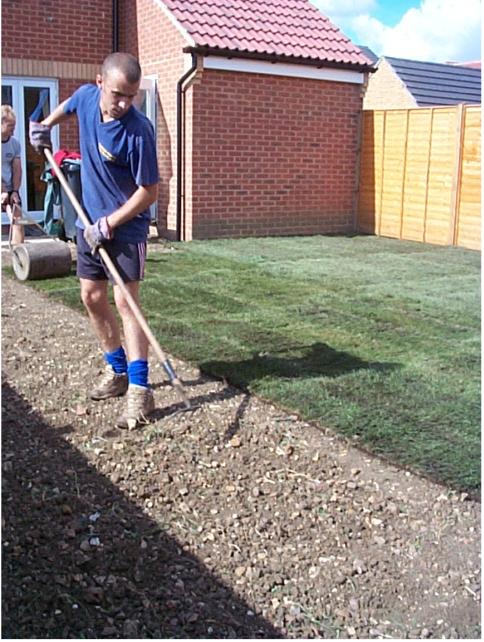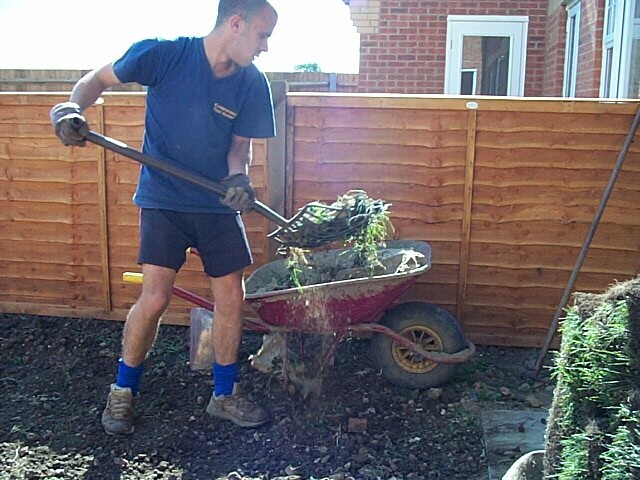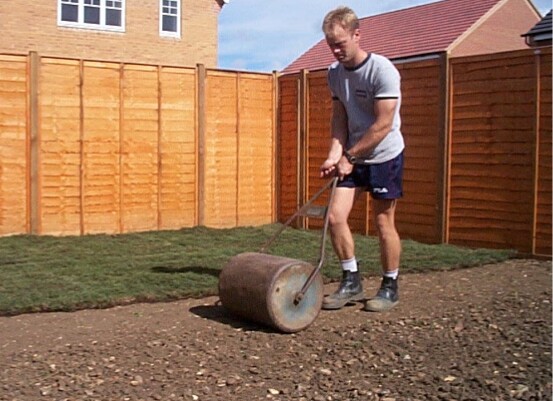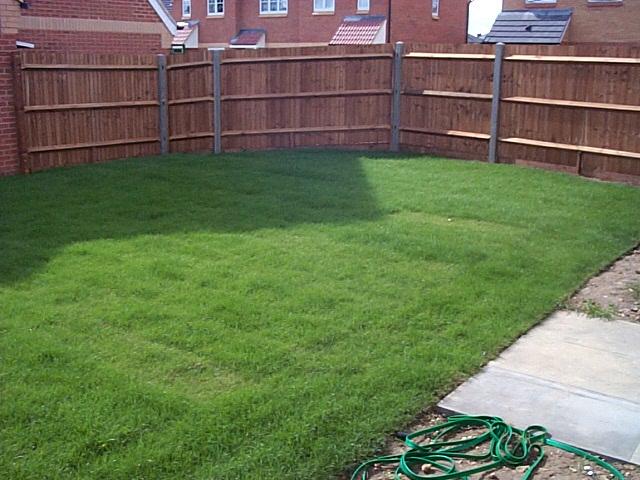How to Lay Turf
Laying turf - a day's job in most cases. If you have a large area, or want to split the job up, spend one day preparing the surface and the second day laying the turf.
A relatively simple operation if hard work, the steps are;
![]() Remove large stones, weeds and other debris.
Remove large stones, weeds and other debris.
![]() Rotavate to loosen soil up, rake and again
remove weeds, stones etc.
Rotavate to loosen soil up, rake and again
remove weeds, stones etc.
![]() Move soil about to level the site if necessary.
Rake smooth.
Move soil about to level the site if necessary.
Rake smooth.
![]() Firm soil down, shuffle over the ground with both
feet together, make sure the whole area has been compacted
this way.
Firm soil down, shuffle over the ground with both
feet together, make sure the whole area has been compacted
this way.
![]() A fertiliser can be applied at this point if desired.
A general one such as Gromore or blood, fish and bone. Make
sure you rake it in well to the soil before the turves are
laid, then water well and leave overnight before laying
turves if possible.
A fertiliser can be applied at this point if desired.
A general one such as Gromore or blood, fish and bone. Make
sure you rake it in well to the soil before the turves are
laid, then water well and leave overnight before laying
turves if possible.
![]() Lay turves (green side up), stagger joins, take
care not to stretch turves, they can be left for 2 or 3
days still rolled up if absolutely necessary, but should
ideally be laid the same day that they are lifted
Lay turves (green side up), stagger joins, take
care not to stretch turves, they can be left for 2 or 3
days still rolled up if absolutely necessary, but should
ideally be laid the same day that they are lifted
![]() Water turves to help settle them down, give a really
good soak.
Water turves to help settle them down, give a really
good soak.
![]() Stay off the grass for at least two weeks, longer
if possible. Water well every 2-3 days during dry spells.
Stay off the grass for at least two weeks, longer
if possible. Water well every 2-3 days during dry spells.
When to Lay Turf
Turf can be laid at any time of year in the UK, some times are better than others however:
Winter - Avoid frosty days, in fact you probably won't get it delivered as the turf merchants won't lift it then. Growth is very slow and you'll need to stay off it for much longer than the usual 2 weeks - how long? - depends on the temperature, if it's below 5C (41F) then there is no growth at all and those days don't count. I'd say about 2 months to be safe which doesn't matter probably if you don't have pets, but does if you do.
Spring - A good time, early spring is better than late spring. Watch out for dry periods later on and water as appropriate.
Summer - Best avoided if possible. Dry periods spell problems or much effort and a high water bill. High temperatures means that the grass stops growing.
Autumn - Best of all. Cooler days but not too cool means the grass grows well, usually dampish so less need to water and the grass is less likely to be walked on.
Turf Quality
Beware meadow turf. You may be offered turf that seems significantly cheaper than from other sources. The chances are that this will be "meadow turf". This is grass that has been growing in a field some-where, not initially intended for lawns, and is then lifted and sold. It will often contain weeds and coarse wild grasses. It can be used, but is really "spoiling the ship for a ha'peth of tar". Make sure you buy cultivated turf that has been grown as a crop specifically for lifting and laying, it will be on good soil, weed free and have the right kinds of grass species in it.
For most situations standard "Amenity grade turf" is more than adequate, this is not bowling green and it isn't rough grassland. It looks good with a modicum of care and will withstand reasonable amounts of trampling by the feet of both people and pets.
Make sure you ask before you buy, and beware
bargains!
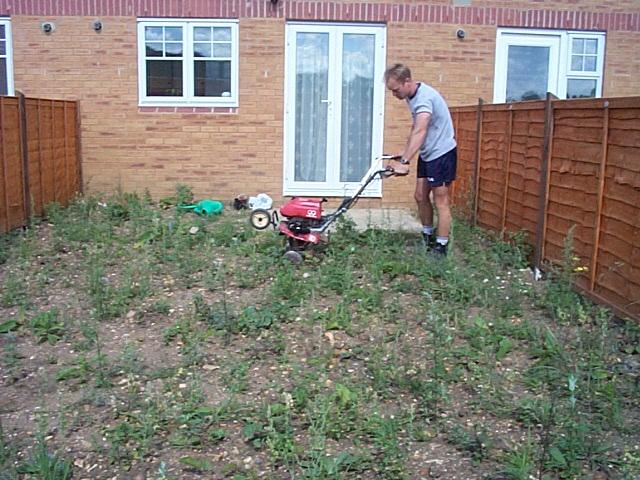
The starting point for your turf laying may be very uninspiring, particularly if the property is new and turf is not provided as in these pictures. Remove particularly large stones by hand initially so as not to damage the rotavator blades.
Here a small rotavator is being used to loosen larger weeds to help their removal. Perennial weeds are best dug up, cutting off the top-growth may leave the roots which will then grow again through the new turf.
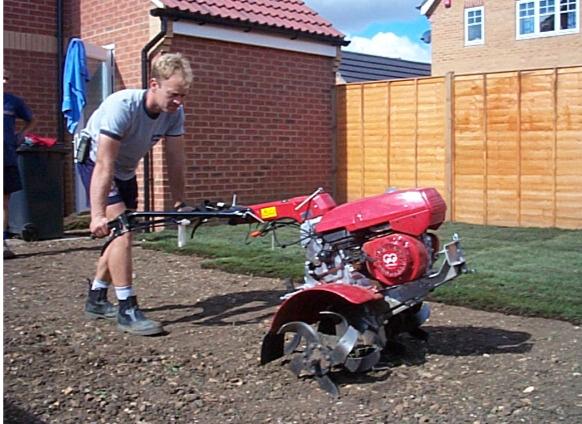
The next job is to rotavate the whole area. The larger the rotavator, the quicker it will be. Rotavators are available from tool hire shops, who will often deliver and collect. Do not underestimate the effort involved in controlling one of these machines, particularly in manoeuvring around a small garden. Depending on the state of the soil, two or three circuits should be enough. Smaller machines are available and are lighter to control, but will obviously take longer to do the same job.
Two weeks on the result is a vibrant green lawn. The edges of individual turves can be made out, but very shortly everything will blend in. If there is a dry spell, the lawn will need to be watered every few days for the first month or so. A good soak twice a week is better than a daily dribble. The lawn should not be walked on for at least two weeks as not to damage the fine newly developing grass roots as they grow out of the turf into the soil below.
If there are gaps between the turves, then fill in using a mix of sand and peat, the grass will soon knit across the top.
With thanks to Sid and Richard - Sid Bibby Turf- Cambridgeshire and neighbouring counties
Table 'coolant_db.t&m' doesn't exist
